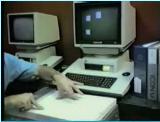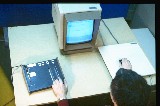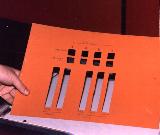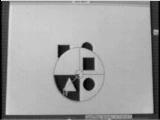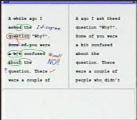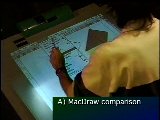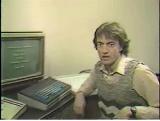 |
An Informal Study of Selection-Positioning
Tasks
(13 min. 17 sec.) University of Toronto 1982 |
A large part of my work has to
do with compound rather than individual atomic tasks. This is an
early example, which compares a number of different approaches to articuluating
selection/positioning tasks. The study forshadows our later interest
in marking menus, and grew out of our work on the SSSP
(especially the score editing tools). What is frightening about
this video is, on the one hand, how young I was, and on the other, how
little my message has changed. Sigh.
Ref:
|
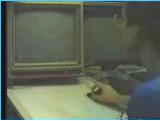 |
"Etch" A Study in Marking-Based
Interaction
(4 min. 1 sec.) University of Toronto 1983 |
The overall complexity of marking
based systems can be reduced if one can impose some underlying rules or
structure on the dialogues. This study illustrates one example of
attempting to do so, showing how a basic vocabulary can apply to different
types of data, such as text or graphics.
Ref:
|
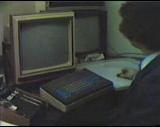 |
Menulay - A UIMS for
Rapidly Sketching, Prototyping and Implementing User Interfaces
(3 min. 51 sec.) University of Toronto 1983 |
Menulay was an early user interface
management system (UIMS). As the video shows, it was done at a time
when calligraphic, rather than raster scan displays were common (although
it did handle both). As is shown, it enabled the user to rapidly
create rich media interfaces.
Ref:
|
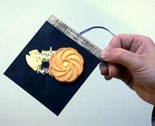 |
Issues & Techniques in Touch-Sensitive
Tablet Input
(9 min. 7 sec.) University of Toronto 1985 |
An overview of considerations and techniques
in the use of touch tablets is presented.
This includes identifying a few key attributes of touch tablets that make them
attractive, compared to mice and trackballs, for example, in certain situations.
Touch tablets of different form-factors are considered, including integrated
into a PDA. Likewise, there is a demonstration of how a single tablet can
be partitioned into a (limited) number of virtual devices, and still be used
eye-free. The tape concludes with a brief introduction of the multi-touch
tablet presented more fully in the next video, below.
Ref:
|
| A Multi-Point Touch Sensitive
Tablet
(3 min. 8 sec.) University of Toronto 1985 |
I have always been interested in the potential
of touch tablets. What always seemed a shame is how few supported
pressure, or any way of sensing the the degree of touch, or had the capability
to sense more than one point of contact at a time. This is a prototype
tablet that did both..
Ref:
|
|
| A Study in Two-Handed Input
(4 min. 56 sec.) University of Toronto 1986 |
This is the first experimental work that
I participated in. This study was my first formal work in bimanual
input, although two-handed input was something that I had done in practice
from the start. However, this paper established this as an important
theme in my research career.
Ref:
|
|
| Templates on Touch Tablets
to Support Virtual Devices
(1 min. 55 sec.) University of Toronto 1990 |
One of the main reasons that touch
tablets interested me was that you didn't have any mechanical intermediary
between your hand and the tablet. Hence you could use multple hands
and/or fingers, and carve up the space into multiple virtual devices, much
like the window manager on a display.
Ref:
Buxton, W. (1994). Combined keyboard / touch tablet input device, Xerox Disclosure Journal, 19(2), 109-111. |
|
| Gedit
(2 min. 5 sec.) University of Toronto 1991 |
This is a video showing some of the very
early work on "marking menus." This clip does not demonstrate everything
in the paper, but gives the flavour of some of the relevant issues.
Ref:
|
|
| MATE
(3 min. 54 sec.) University of Toronto 1993 |
MATE was a prototype that investigated the
design of a tool to support the life-cycle of a document after it had been
written, but before completion, i.e., annotaion, correction, editing, etc.
It supported collaboration and was especially considering the use of pen-based
interfaces. It has perhaps even more relevance now than when it was
originally done..
Ref:
|
|
|
|
Toolglass & Magic Lenses
(10 min. 12 sec.) Xerox PARC 1993 |
Toolglass and Magig Lenses represent
a new paradigm for two-handed input that is based on how we undertake bimanual
asymetric tasks in the everyday world. The technique exploits everyday
skills, increases the power of expression, yet can also build on existing
GUI designs, thereby not requiring a whole new design.
Ref:
|
|
|
The Chameleon: Spatially-Aware
Palmtop Computers
(5 min. 5 sec.) University of Toronto 1993 |
This video demonstrates an early prototype of a hand-held
digital device where one navigates through the information displayed in a manner
somewhat analogous to how one looks at the world through a camera's viewfinder:
one pans left/right & up/down to change the firection of view, and moves in to
get a close-up and out to get an overview. In order to avoid arm fatigue, or
uncomfortable positions, or always moving images, a "clutch" button is included
so that one can engage or disengage the navigation. Effectively, this enables
one to reset the origin of the coordinate space. Ref:
|
| Graspable User Interface
(3 min. 34 sec.) University of Toronto 1997 |
This video introduces the notion
of what we call "graspable" user interfaces. These have also been
called "props based" or "tangible" UIs. It is a style of UI in which
key components are manifest in graspable physical props whose physical
form relates to their function.
Ref: Related work: [1] |
